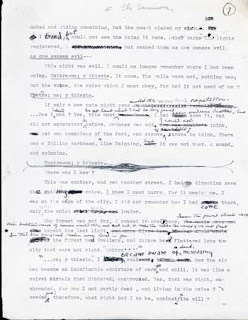_____
I added a few images from post cards of the 1920's and 1930's, slightly before the time that HPL saw Nantucket.
_____























 _____
_____From Famous Fantastic Mysteries October 1941 interior Virgil Finlay Illustration
_____








 Letter signed (ALS) to "Dear Coates [Walter J. Coates] on both sides of single 5 1/2" x 9" sheet, dated "Tuesday" (1926?), signed "HPL". "Coates was an amateur journalist in Vermont, editor of DRIFTWIND, and promoter of regional poetry. He published a good deal of Lovecraft's poetry but is most noted for publishing his essay, 'The Materialist Today,' an impassioned defense of atheism, in the October 1926 DRIFTWIND, following a 15-copy pre-print pamphlet, one of the rarest pieces of Lovecraftiana. // This letter, following a thread of some previous correspondence, is largely a rant about the debased literary taste of contemporary Americans, corrupted by commercialism and decadent intellectuals and, with the influence of Jews and other non-Aryan elements as the root cause of both -- or perhaps all -- problems. // The issue of Lovecraft's anti-Semitism (like most things about him!) is not entirely straightforward. He talked a good anti-Semitic game in theory but when it came down to particulars he married a Jew and maintained warm personal friendships with Jewish writers, including Samuel Loveman and Robert Bloch. // The auctioneer continues: In some ways he is the opposite of radicals who loudly pronounce their love of humanity while beating their wives, disowning their children and cheating their partners, disdaining 'personal morality' as a bourgeois luxury. // Lovecraft's racial views, as obnoxious as they are, were not especially unusual then (or, in some quarters, now). It should also be understood that Lovecraft as an author of letters was no less literary than as an author of stories or poems, being concerned primarily with the creation of character, mood, diction, etc. In many ways, the 'Lovecraft' he fashioned in his letters had no very strict resemblance to the man who lived in the real world and moved about among flesh-and-blood people. He was always eager (or desperate) in his letters, as in all his writing, to strike a memorable pose -- as a bulwark against the howling void of the cosmos. Militating also against one's revulsion at his call for 'literary & aesthetic fumigation' is the Socratic irony of how summarily Lovecraft, like other armchair fascists, would have been dealt with in the (real rather than imagined) Third Reich, where his writings would undoubtedly have been condemned as decadent and where he might well have rubbed shoulders with 'Messrs Cohen & Levi' on the way to the showers." -- Robert Eldridge. The usual mailing creases, fine. (#114494) Price: $3,750.00
Letter signed (ALS) to "Dear Coates [Walter J. Coates] on both sides of single 5 1/2" x 9" sheet, dated "Tuesday" (1926?), signed "HPL". "Coates was an amateur journalist in Vermont, editor of DRIFTWIND, and promoter of regional poetry. He published a good deal of Lovecraft's poetry but is most noted for publishing his essay, 'The Materialist Today,' an impassioned defense of atheism, in the October 1926 DRIFTWIND, following a 15-copy pre-print pamphlet, one of the rarest pieces of Lovecraftiana. // This letter, following a thread of some previous correspondence, is largely a rant about the debased literary taste of contemporary Americans, corrupted by commercialism and decadent intellectuals and, with the influence of Jews and other non-Aryan elements as the root cause of both -- or perhaps all -- problems. // The issue of Lovecraft's anti-Semitism (like most things about him!) is not entirely straightforward. He talked a good anti-Semitic game in theory but when it came down to particulars he married a Jew and maintained warm personal friendships with Jewish writers, including Samuel Loveman and Robert Bloch. // The auctioneer continues: In some ways he is the opposite of radicals who loudly pronounce their love of humanity while beating their wives, disowning their children and cheating their partners, disdaining 'personal morality' as a bourgeois luxury. // Lovecraft's racial views, as obnoxious as they are, were not especially unusual then (or, in some quarters, now). It should also be understood that Lovecraft as an author of letters was no less literary than as an author of stories or poems, being concerned primarily with the creation of character, mood, diction, etc. In many ways, the 'Lovecraft' he fashioned in his letters had no very strict resemblance to the man who lived in the real world and moved about among flesh-and-blood people. He was always eager (or desperate) in his letters, as in all his writing, to strike a memorable pose -- as a bulwark against the howling void of the cosmos. Militating also against one's revulsion at his call for 'literary & aesthetic fumigation' is the Socratic irony of how summarily Lovecraft, like other armchair fascists, would have been dealt with in the (real rather than imagined) Third Reich, where his writings would undoubtedly have been condemned as decadent and where he might well have rubbed shoulders with 'Messrs Cohen & Levi' on the way to the showers." -- Robert Eldridge. The usual mailing creases, fine. (#114494) Price: $3,750.00














